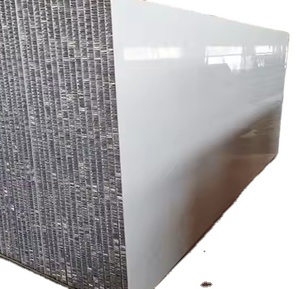
All categories
Featured selections
Trade Assurance
Buyer Central
Help Center
Get the app
Become a supplier

(206 products available)




















































A timber cladding system is an external wooden covering that can give a building a streamlined and contemporary outlook. In both commercial and residential settings, these systems build up energy efficiency and safeguard against unfavorable weather. The types include:
In this type of cladding, one board is nailed to the others, creating a system that allows for good ventilation and water resistance. It is known for its great durability and appeals to people who want a weathered or rough look.
Shiplap cladding has edges that are cut to make the boards fit together like puzzle pieces. This kind of cladding has a clean, level finish that makes it look simple and neat even though it gives great protection from rain and wind.
Unlike traditional horizontal cladding, this option places boards upright. This design looks sleek and sophisticated while giving excellent shielding from the elements. People wanting unique building styles often choose vertical cladding.
This kind of cladding tries to capture the old-world charm of log cabins. With either round or split logs used as a skin, it forms a rustic yet modern appearance. It appeals to those after a natural, warm look for their building.
This cladding uses strips of wood called battens placed over a solid board base. The result is a strong, layered style that provides great durability against the weather. People who want something different from flat cladding often choose this option.
Natural timber is used to make wood siding, which is used as an exterior covering for buildings. Many types of trees, called hardwoods and softwoods, offer different kinds of wood for various cladding styles. Over time, timber has remained a popular building material because of its strength, lightness, and natural beauty.
Timber cladding systems are used to cover buildings and are very durable. Many types of tree wood, known as {hardwoods} and softwoods, are suited for making timber cladding. Each type of tree offers unique qualities that enhance the cladding's endurance. Proper maintenance and treatment protect timber from water, insects, and sun damage, allowing it to last for decades. Vents and gaps in the cladding encourage good airflow that helps keep the wood dry to prevent mold and rot. That way, the cladding can keep looking its best while shielding the building for years.
The longevity of timber cladding can be greatly enhanced through regular maintenance. Oiling or sealing the wood prevents water damage, UV degradation, and insect infestation, significantly extending its lifespan. Additionally, a well-designed ventilation system behind the cladding helps to dissipate moisture and heat, thus preserving the integrity of the timber over time. When properly cared for, timber cladding can endure the elements for up to 30-50 years, depending on the type of wood used and environmental conditions.
Timber cladding systems are used in construction to cover building exteriors. They create a protective shell that guards against harsh weather, including rain, wind, and sun. These cladding materials also provide insulation, helping to keep buildings warm in the cold and cool during heat. The result is less energy used for heating or cooling the space inside the building.
Timber has a warm and inviting look that can enhance a building's beauty. People choose timber cladding for their homes or community buildings because it looks natural and modern. This appeal raises the property's overall worth. Beyond these functional benefits, timber cladding is popular in sustainable construction due to its eco-friendly attributes. Sourced from responsibly managed forests, it contributes to the growing movement of green building practices.
Timber cladding systems are widely employed in commercial construction projects. For instance, retail stores and office buildings utilize timber cladding boards to create a contemporary facade that appeals to customers and clients. In urban developments, residential units featuring timber cladding are in high demand, catering to those seeking modern, eco-friendly homes.
Timber cladding systems are a popular choice for modern building designs, both for residential and commercial structures. These wooden exteriors offer a sleek and natural look that suits various architectural styles. Whether a rustic log cladding or a contemporary shiplap finish, timber cladding enhances the beauty of any building.
Timber cladding complements other materials like glass, metal, and masonry. This versatility allows it to be part of mixed-material facades, enhancing the overall design. As architects experiment with different profiles and arrangements, timber cladding plays a key role in innovative contemporary designs.
The warm and textured appearance of timber cladding creates an inviting atmosphere for both the exterior and interior spaces. This natural element softens harsh urban environments and connects people with nature. Its aesthetic appeal enhances the building's beauty and improves the surrounding environment.
Timber cladding systems are popular for interior applications, adding warmth and character to indoor spaces. Timber feature walls enhance living rooms, commercial lobbies, or public areas, creating a focal point. Its use indoors balances modern and natural elements, enriching the surrounding decor.
A1: Timber cladding, when sourced from certified forests, emerges as a sustainable choice. Its carbon capture properties and renewability make it an excellent green building option.
A2: Routine tasks like cleaning and applying protective oils or stains keep cladding weather-resistant. Proper care enhances durability and prevents decay.
A3: With the right treatment and naturally rot-resistant woods like cedar, cladding can thrive in wet areas, maintaining its integrity and beauty.
A4: Timber cladding acts as insulation, reducing energy waste. This insulation keeps interiors warm in winter and cool in summer, lowering energy bills.
A5: While relatively low-maintenance, timber cladding benefits from periodic sealing and inspections to ensure long-lasting protection against the elements.